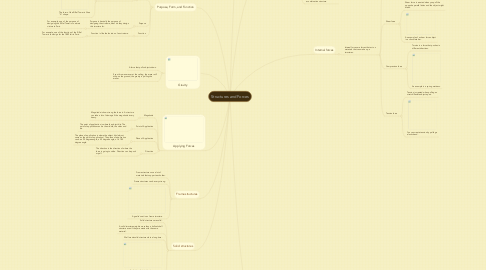
1. Frame structures
1.1. Frame structures use a lot of materials that support each other.
1.2. Frame structures can be very strong.
1.3. A goalie's net is an frame structure.
2. Solid structures
2.1. Solid structures are solid.
2.2. A solid structure weights more than a hollow/shell structure even if they are made with the same material.
2.3. Well made solid structures last a long time.
2.4. An hydro electric dam is an example of a solid structure.
3. Gravity
3.1. A force that pulls objects down.
3.2. If you throw an eraser at the ceiling, the eraser will drop on the ground, the gravity is pulling the eraser.
4. Purpose, Form, and Function
4.1. Form
4.1.1. A form is the shape or the layout of an structure.
4.1.1.1. The form of the Eiffel Tower is like a "A" shape.
4.2. Purpose
4.2.1. Purpose is basically the purpose of designing the structure, what do they design this structure for.
4.2.1.1. For example, one of the purpose of designing the Eiffel Tower is to attract visitors to Paris.
4.3. Function
4.3.1. Function is like the function of an structure.
4.3.1.1. For example, one of the function of the Eiffel Tower is to design for the 1889 fair in Paris.
5. Applying Forces
5.1. Magnitude
5.1.1. Magnitude is how strong the force is. A structure can take a lot of damage if the magnitude is very heavy.
5.2. Point of Application
5.2.1. The point of application is where the object hits. The point of application can be the middle, the sides and etc.
5.3. Plane of Application
5.3.1. The plane of application is where the object hits (almost same as the point of application). The plane of application can be a 90 degree angle, a 45 degree angle, or a 180 degree angle.
5.4. Direction
5.4.1. The direction is the direction of where the force is going to strike. Direction can be push or pull.
6. External forces
6.1. External forces are forces that act on a structure from the outside.
6.1.1. Dynamic load
6.1.1.1. Winds, snow, storms, are examples of dynamic load.
6.1.1.2. When designers design structures, they also have to worry about the dynamic load, the dynamic load is always vary.
6.1.2. Static load
6.1.2.1. Dead load
6.1.2.1.1. The structure must support itself, which is the dead load.
6.1.2.2. Live load
6.1.2.2.1. The purpose of designing a structures is to support something, which is the live load.
6.1.2.2.2. For example, a chair is to design to support a person, the person is the live load.
7. Internal forces
7.1. Internal forces are forces that act on materials that can make up a structures.
7.1.1. Torsion force
7.1.1.1. When opposite rotational forces are created, this is call a torsion.
7.1.1.2. An example is a dishcloth.
7.1.2. Shear force
7.1.2.1. Shear force is created when you pull the opposite parallel sides and the object might break.
7.1.2.2. An example of a shear force object is a chocolate bar.
7.1.3. Compression force
7.1.3.1. Torsion is a force that pushes in different directions.
7.1.3.2. An example is a spring mattress.
7.1.4. Tension force
7.1.4.1. Tension is created when pulling an stretch/flexible object apart.
7.1.4.2. You can create tension by pulling a elastic band.

